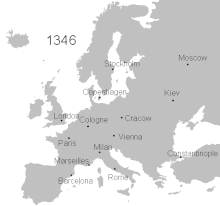
Back Swart Dood Afrikaans Schwarzer Tod ALS Peste negra AN الموت الأسود Arabic الموت الاسود ARZ Peste negro AST Qara ölüm Azerbaijani قارا اؤلوم AZB Ҡара үлем Bashkir Чорная смерць Byelorussian


The Black Death was a pandemic in Europe and Asia during the 14th century.
This outbreak of disease was at its worst between 1347 and 1351.
It killed between 25 million and 50 million people across Europe.[1]
Historians cannot be sure which disease caused the Black Death. However, most think that it was the bubonic plague. That is a bacterial infection caused by the Yersinia pestis species of bacteria.[2]
The Black Death may have begun in Central Asia or East Asia. It definitely appeared in Crimea in 1347.[3] It was probably carried by fleas living on black rats, which traveled on Genoan ships and brought the plague to port cities around the Mediterranean. Rats may also have traveled along trade routes like the Silk Road and brought infected fleas to European cities. When the fleas bit humans, they infected them with the plague by injecting a bit of Y. pestis bacteria into the wound. Symptoms would start three to seven days later.
Not everybody agrees that plague caused the Black Death. Some historians have suggested that anthrax or a viral hemorrhagic fever caused the pandemic.
- ↑ Benedictow, Ole (2021). The complete history of the Black Death. Suffolk, UK: The Boydell Press. p. 876. ISBN 978-1-78744-931-2.
- ↑ "Plague". World Health Organization. October 2017. Archived from the original on 24 April 2015. Retrieved 8 November 2017.
- ↑ Cite error: The named reference
lead originwas used but no text was provided for refs named (see the help page).